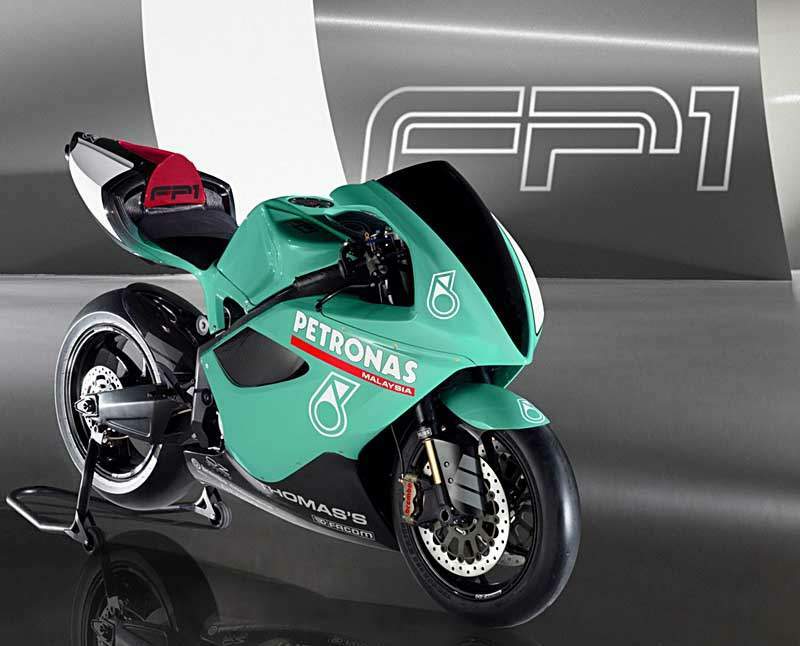
|
|
|
|
|
|
Classic Bikes
Custom Bikes
Individual
Racing Bikes AJP
AJS
Aprilia
Ariel
Avinton / Wakan
Bajaj
Benelli
Beta
Bimota
BMW
Brough Superior
BRP Cam-Am
BSA
Buell / EBR
Bultaco
Cagiva
Campagna
CCM
CF Moto
Combat Motors
Derbi
Deus
Ducati
Excelsior
GASGAS
Ghezzi Brian
Gilera
GIMA
Harley Davidson
Hero
Highland
Honda
Horex
Husaberg
Husqvarna
Hyosung
Indian
Jawa
Kawasaki
KTM
KYMCO
Laverda
Lazareth
Magni
Maico
Mash
Matchless
Mondial
Moto Guzzi
Moto Morini
MV Agusta
MZ / MuZ
NCR
Norton
NSU
Paton
Peugeot
Piaggio
Revival Cycles
Roland Sands
Royal Enfield
Sachs
Sherco
Sunbeam
Suzuki
SWM
SYM
Triumph
TVS
Ural
Velocette
Vespa
Victory
Vincent
VOR
Voxan
Vyrus
Walt Siegl
Walz
Wrenchmonkees
Wunderlich
XTR / Radical
Yamaha
Zero
Video
Technical
Complete Manufacturer List
|
Foggy Petronas FP1
The FP1 was originally developed as a 998cc triple for entry into the MotoGP series by PETRONAS and Sauber. However in late 2001 PETRONAS decided that they would contest the world superbike series instead in conjunction with Team Foggy Racing Ltd, Thereafter know as Foggy PETRONAS Racing. This change meant that a number of major changes had to be made to the machine for it to be eligible to race in 2002. The first and most important was the reverse in-line triple engine had to be reduced to 900cc to comply with the technical specifications for triples in the superbike class. This was then mated with a chassis that was designed and built in record time by the team. A state of the art exhaust system was developed which features a unique three into one into two into three arrangement which allows the engine to run at lower revs.
Foggy Petronas Racing FP1 must produce
150 to participate in the World Superbike Champion Chip. The 75 was first
produced at the SFX in England and approved by the FIM in March, in July, is
still 75 clear. These are produced in Modena, Malaysia's largest mc /
scooter manufacturer.
Some of the other technical
changes made include:  Where are they know? Hoard of Foggy-Petronas FP1 road bikes found in Essex MCN has discovered a secret hoard of 60 £25,000 Foggy-Petronas FP1 road bikes in a bunker in Essex. Carl Fogarty – race team manager and figurehead of the ill-fated FP1 project – said when told the news: “You’re joking – that’s amazing!” It had been thought – and stated by the team – that the bikes were shipped to Malaysia five years ago and disposed of. But in fact virtually all the bikes initially produced to homologated the FP1 for WSB racing are still on UK soil. The collection – worth around £2m – is held in a state of suspended animation awaiting, with the bikes’ owner – Malaysian oil giant Petronas – keen to draw a veil over the whole episode. The firm burned £30m on a WSB program that was intended to kick-start a Ducati-sized bike manufacturing business in Malaysia, but in fact petered out with a 21st place championship finish in 2006. The bikes were manufactured for Petronas by engineering firm MSX International in Basildon in Essex in record time in 2002, around engines designed by Austrian firm Suter Racing. The idea was that the production process would then be replicated in Malaysia and form the start of a range of higher and lower-spec bikes running to ten thousand and more. 75 road bikes were built in Essex, followed by another 75 in Malaysia six months later, Though the business that produced this first batch has since changed hands the bikes are still there, now in possession of engineering firm Arrk R&D, which also retains key MSXI staff who worked on the FP1. Tony White is one of them: “They were perfect” is all he will say about the bikes, the existence of which Petronas gagging orders prevent him from acknowledging.
As chief executive of Foggy Petronas Racing, Murray Treece was the go-between for Petronas and the UK engineers who developed the road bike. He says: “Our staff developed the race bike and then were involved in transferring the design and supplier information over to the road bike team. Exactly what happened after that to the road bikes is unknown (by me at least).” It was a transition in which the FP1 lost virtually none of its clean racing looks, but a fair chunk of its power – down to 127bhp from 185bhp. Even so, at 181kg it should still have been a competitive road bike – though it was never released for road test. Eight years later only the non-radial brakes date the stark, stylish lines of the turquoise triples. Foggy said at the time: “There is no doubt that this will be the most beautiful bike on the roads. It combines cutting edge technology with real elegance and has set new standards at the top end of the road bike market”. Treece echoes: “It was a beautiful looking and sounding machine. I wish I owned one”. Treece believes Petronas underestimated the challenge in bringing a bike to market in such a short time with no infrastructure.
Priceless or worthless? Source MCN Feb 2010
|
|
|
Any corrections or more information on these motorcycles will be kindly appreciated. |